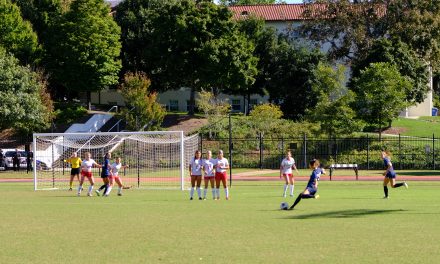On Feb. 29, Atlanta welcomed nearly 700 runners — 235 men and 456 women — for the U. S. Olympic Team Trials. Each runner competed for one of six spots on the 2020 Olympic Team. The course, which consisted of three 8-mile loops and a 2-mile diversion to the finish, was unusually hilly and featured an elevation gain of 1,389 feet. The sloping course, paired with blustering 18 mph winds, was sure to be a challenge.
Heading into the race, previous Olympian Galen Rupp was already the clear favorite to win. He had already represented the U.S. at the 2016 Summer Olympics in Rio de Janeiro, where he won a bronze medal in the marathon. Despite his success, there was still some doubt that he would qualify after a surgery to correct his Haglund’s deformity (a defect in the heel bone) sidelined him for a year and a half.
Other favorites included Leonard Korir, who also represented the U.S. at the 2016 Summer Olympics in the 10,000-meter race and holds the fastest marathon debut by an American in history at 2 hours, 7 minutes and 56 seconds. Scott Fauble, Jared Ward and Jacob Riley all also held solid qualifying times heading into the Atlanta Trials.
Among the women, Desiree Linden was the crowd favorite. As the most experienced woman in the field, Linden entered the competition hoping to make history as the first American woman to earn a spot on three Olympic marathon teams.
Other notable entrants included Jordan Hasay, who had the fastest qualifying time heading into the marathon, and Amy Cragg, who won the 2016 Trials held in Los Angeles.
Before the race commenced, the athletes hopped around at the start line in a desperate attempt to stay warm amid the fierce winds. The men were first to take off, with the women following soon after.
The athletes were both helped and hindered by the enthusiastic crowd that day.
“The crowd was absolutely crazy,” third-place finisher Sally Kipyego said. “It felt like they were right on the course. It can be really exciting, but it can also get in the way. But around the last few miles, having people scream at you and cheer you was great.”
Most men ran conservatively throughout the race. At the 6-mile mark, Ryan Shrader and Dan Nestor decided to make their move. By the end of the first 8-mile loop, both had gained a 30-second lead on the rest of the pack.
The women opted to stay in a large pack throughout the first 8-mile loop, a smart decision that helped block the strong winds and preserve the racers’ energies.
Sixteen miles in, Rupp and the rest of the men’s front pack had caught up to Nestor and Shrader. At the beginning of the third and final loop, Rupp finally decided to make his move. Instead of staying in the middle of the conservative pack, he picked up the pace and separated himself from the rest of the group.
After the race, Rupp explained his decision to pick up the pace at a relatively early juncture.
“The biggest thing for me was being conservative and tucking in as much as possible,” Rupp said. “I took off a little bit earlier than I initially anticipated. Before the race, [my coach] Mike [Smith] said, ‘Trust yourself, you’ve been doing this for a long time.’ The more the race went on, the more confident I got. It just felt like the right time.”
Shrader, who had by then lost some ground on the lead group, ultimately decided to drop out of the race. He was not the only athlete to drop, however. The women’s race was shaken after a hamstring injury forced Cragg to depart, leaving the field even more open than before.
Rupp increased his pace throughout the race. His final seven miles all fell beneath the 5-minute mark, and he crossed the line first with a time of 2:09:20, a solid 42 seconds before Jacob Riley, the second-place finisher.
An intense sprint to the finish decided the final two spots. Riley barely outsprinted Abdi Abdirahman for second place, finishing in at a personal best of 2:10:02 and leaving Abdirahman to finish at 2:10:03. Although not expected to finish in the top three, Abdirahman has now qualified for his fifth Olympic games. Both secured their spot over Korir, who crossed the line a mere three seconds later.
Abdirahman attributed his success on the Atlanta course to his intense training in Ethiopia.
“I was in Ethiopia since December,” he said. “I have a lot of good guys I train with there. We did some great work — a lot of hill work. If this course had been flat, I might not have placed where I did.”
None of the women who were favored to win earned a spot on the Olympic team. The first to cross the finish line was Aliphine Tuliamuk, who broke the tape at 2:27:23. Seven seconds later, Molly Seidel — who was running her first marathon ever — crossed the line in second place to qualify. It was not until 2:28:52 that the final qualifier, Kipyego, crossed the line and rounded out the team. Linden barely missed qualifying and making history, crossing the line in fourth place with a time of 2:29:03. She will run the Boston marathon in just seven weeks, leaving very little recovery time.
Afterward, Seidel spoke to the press about her mindset heading into her first marathon race.
“Going into it, I was just trying to keep a clear head,” Seidel said. “I wasn’t really thinking through the first part of the race. I wasn’t paying attention to miles or pace, I was just going off feeling. The last part definitely hurt, but it’s okay to hurt. It’s not okay to stop.”
Despite both teams’ surprising makeups, the athletes already seem to be developing chemistry with their new teammates.
“It’s just so nice to share this stage with these two beautiful women,” Tuliamuk said. With qualifications now over, the athletes will begin training for the Summer Olympics in Tokyo. You can see the athletes compete again on Aug. 8 and Aug. 9 in Sapporo, Japan.





